Complete Solutions to SECTION-II of chapter SAMPLE PAPER 2012 of Class 10 book with complete answers and questions
| Class 10 | PHYSICS |
| Chapter | SAMPLE PAPER 2012 |
| GURUKUL | SECTION-II |
| Number Of Questions | 43 |
| Academic Year | 2023-24 |
Which of the following remains constant in uniform circular motion. Speed or Velocity or both ?
02:29View SolutionName the force required for circular motion. State its direction.
01:44View SolutionState the class of levers and the relative positions of load (L), effort (E) and fulcrum (F) in each of the following cases.
(1) A bottle opener
(2) Sugar tongs.02:16View SolutionWhy is less effort needed to lift a load over an inclined plane as compared to lifting the load directly ?
02:00View SolutionA moving body weighing 400 N possesses 500 J of kinetic energy. Calculate the velocity with which the body is moving. `(g=10ms^(-2))`
01:34View SolutionUnder what condition will a set of gears produce :
(1) a gain in speed
(2) a gain in torque.04:01View SolutionWhat is meant by the term 'critical angle'?
02:01View SolutionHow is it related to the refractive index of the medium ?
01:09View SolutionA tank of water is viewed normally from above.
(a) State how does the depth of the tank appear to change.
(b) Draw a labelled ray diagram to explain your answer.05:27View SolutionA ray of light PQ is incident normally on the hypotenuse of a right angled prism ABC as shown in the diagram given below:
Copy the diagram and complete the path of the ray PQ till it emerges from the prism.02:53View SolutionA ray of light PQ is incident normally on the hypotenuse of a right angled prism ABC as shown in the diagram given below:
What is the value of the angle of deviation of the ray ?
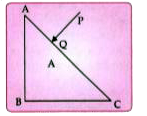 04:56View Solution
04:56View SolutionA ray of light PQ is incident normally on the hypotenuse of a right angled prism ABC as shown in the diagram given below:
Name an instrument where this action of the prism is used.01:03View SolutionA converging lens is used to obtain an image of an object placed in front of it. The inverted image is formed between `F_(2)and2F_(2)` of the lens.
Where is the object placed ?01:56View SolutionA converging lens is used to obtain an image of an object placed in front of it. The inverted image is formed between `F_(2)and2F_(2)` of the lens.
Draw a ray diagram to illustrate the formation of the image obtained.01:15View SolutionWhat is meant by Resonance ?
02:15View SolutionState two ways in which Resonance differs from Forced vibrations.
02:26View SolutionA man standing between two cliffs produces a sound and hears two successive echoes at intervals of 3 s and 4 s respectively. Calculate the distance between the two cliffs.
The speed of sound in the air is `330ms^(-1)`.03:51View SolutionWhy will an echo not be heard when the distance between the source of sound and the reflecting surface is 10 m ?
02:32View SolutionThe diagram below shows the displacement-time graph for a vibrating body.
Name the type of vibrations produced by the vibrating body.
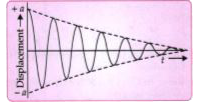 01:12View Solution
01:12View SolutionThe diagram in Fig. shows the displacement time graph of a vibrating body.

Give one example of such vibrations.01:44View SolutionThe diagram in Fig. shows the displacement time graph of a vibrating body.
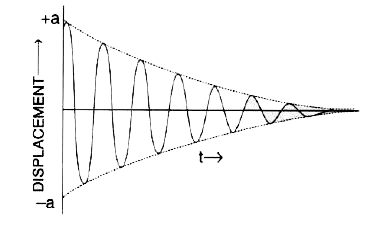
Why is the amplitude of vibrations gradually decreasing ?01:50View SolutionThe diagram in Fig. shows the displacement time graph of a vibrating body.
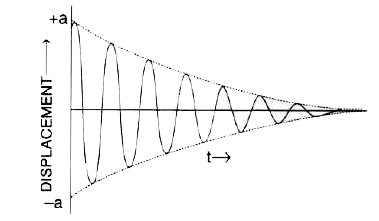
What happens to the vibrations of the body after some time?01:29View SolutionA cell is sending current in an external circuit. How does the terminal voltage compare with the e.m.f. of the cell ?
02:33View SolutionWhat is the role of fuse, used in series with any electrical appliance? Why should a fuse with defined rating not be replaced by one with a larger rating?
05:55View SolutionWhat are the characteristic properties of fuse wire ?
02:31View SolutionWrite an expression for the electrical energy spent in the flow of current through an electrical appliances in terms of I, R and t.
01:32View SolutionAt what voltage is the alternating current supplied to our houses ?
01:04View SolutionHow should the electric lamps in a building be connected ?
01:28View SolutionThree resistors are connected to a 6 V battery as shown in the figure given below :
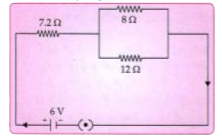
Calculate :
the equivalent resistance of the circuit.01:32View SolutionThree resistors are connected to a 6 V battery as shown in the figure given below :
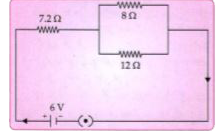
Calculate :
total current in the circuit.02:06View SolutionThree resistors are connected to a 6 V battery as shown in the figure given below :
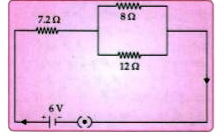
Calculate :
potential difference across the `7.2Omega` resistor.02:46View SolutionWrite an expression for the heat energy liberated by a hot body.
01:24View SolutionSome heat is provided to a body to raise its temperature by `25^(@)C`. What will be the corresponding rise in temperature of the body as shown on the Kelvin scale ?
01:19View SolutionWhat happens to the average kinetic energy of the molecules as ice melts at `0^(@)C` ?
01:19View SolutionA piece of ice at `0^(@)C` is heated at a constant rate and its temperature recorded at regular intervals till steam is formed at `100^(@)C`. Draw a temperature-time graph to represent the change in phase. Label the different parts of your graph.
04:16View Solution40 g of ice at `0^(@)C` is used to bring down the temperature of a certain mass of water at `60^(@)C` to `10^(@)С`. Find the mass of water used.
[Specific heat capacity of water = 4200 `Jkg^(-1)""^(@)C^(-1)`]
[Specific latent heat of fusion of ice = `336xx10^(3)Jkg^(-1)`]02:29View SolutionThe diagram below shows a current carrying loop or a circular coil passing through a sheet of cardboard at the points M and N. The sheet of cardboard is sprinkled uniformly with iron filings.
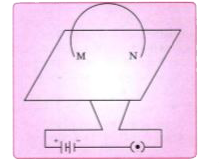
Copy the diagram and draw an arrow on the circular coil to show the direction of current flowing through it.01:01View SolutionThe diagram below shows a current carrying loop or a circular coil passing through a sheet of cardboard at the points M and N. The sheet of cardboard is sprinkled uniformly with iron filings.
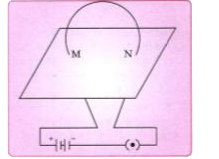
Draw the pattern of arrangement of the iron filings when current is passed through the loop.01:32View SolutionDraw a simplified labelled diagram of a hot cathode ray tube.
01:34View SolutionName a common device where a hot cathode ray tube is used.
00:43View SolutionA certain nucleus X has a mass number 14 and atomic number 6. The nucleus X changes to `""_(7)Y^(14)` after the loss of a particle.
Name the particle emitted.01:00View SolutionA certain nucleus X has a mass number 14 and atomic number 6. The nucleus X changes to `""_(7)Y^(14)` after the loss of a particle.
Represent this change in the form of an equation.01:01View SolutionA certain nucleus X has a mass number 14 and atomic number 6. The nucleus X changes to `""_(7)Y^(14)` after the loss of a particle.
A radioactive substance is oxidized. What change would you expect to take place in the nature of its radioactivity ? Give a reason for your answer.01:16View Solution
SECTION-II questions and complete solutions for chapter SAMPLE PAPER 2012 of SELINA PHYSICS (ENGLISH) of Class 10
